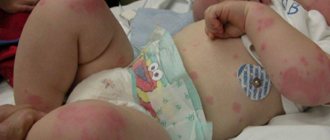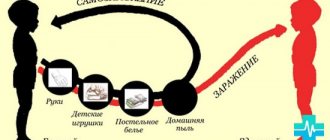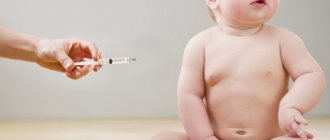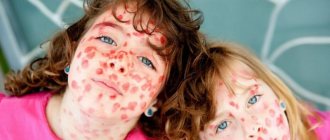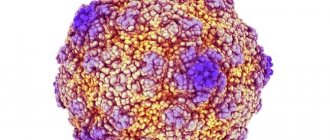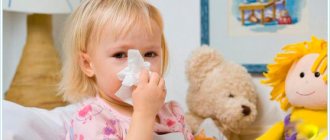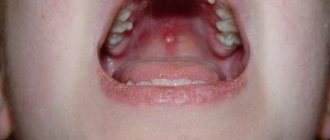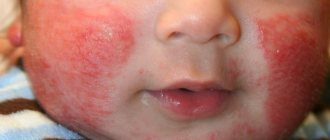Causes of prickly heat
There are many reasons why prickly heat appears in children. The main ones are:
- The weather is too hot . In the heat, the sweat glands are very quickly and actively involved in their work. But only in this case, sweat accumulates not on the dermis, but under it in the form of tiny pink bubbles that protrude slightly above the skin.
- Cold weather and wrapping up your baby . In infants, prickly heat may appear due to the fact that in cold weather parents like to wrap the baby too much. Very dry air due to the operation of heating devices has an adverse effect on the skin. Also, during the cold season, parents worry that the baby will freeze and begin to wrap the child in a hundred clothes. An increase in temperature increases sweating, which causes an increase in the rate of epithelium change. As a result, the sweat glands become clogged and bubbles begin to appear.
- Hygiene . The most important cause of prickly heat in newborns is failure to comply with the most common rules of personal hygiene. If the baby is not bathed every day, the condition of his skin is not monitored, and he is not washed every time after changing the diaper, then skin reactions in the form of irritation and redness begin to appear.
- Increased room temperature . If the temperature in the baby's room is too high, then he overheats and, as a result, the child develops heat rash. Acceptable room temperature is 18-22 degrees. It is especially dangerous when parents use heaters and various devices to heat the air in winter. They dry the skin too much, causing irritation.
- Poor quality clothes . Incorrectly chosen clothes, sleeping items, synthetic rompers - all this provokes prickly heat in newborns. It is important to choose clothes and sleeping items made from natural fabrics that allow the skin to breathe. Otherwise, the baby will whine and become irritated.
- Excess of cosmetic care products . Fatty creams cover the epidermis with a waterproof film, which prevents the skin from breathing and promotes excessive sweat production. This is already causing the appearance of heat rash.
- Infections and acute inflammatory problems that are accompanied by fever. Elevated temperature causes active sweating.
These reasons are the most common, and it is very important to be able to recognize it and eliminate it.
Treatment
To prevent or reduce the likelihood of an unpleasant disease to a minimum, it is necessary to constantly follow preventive measures.
When the temperature is high at home and outside, you should not wrap your baby too tightly. You should always dress your child according to the weather or room temperature.
If you are afraid that your baby will freeze, then it is better to take an extra blanket when going outside and put it in your bag. To find out whether your baby is cold or not, you need to touch the tip of his nose. A cool nose indicates that the newborn is cold and should be covered. But hot means that the child is too hot and should be unwrapped or undressed as quickly as possible.
In the summer, it is not recommended to keep your baby in diapers and diapers 24 hours a day. Even the most expensive and high-quality hygiene items cannot allow enough air to pass through, and the baby’s skin begins to sweat. Therefore, it is best to use a diaper only during walks and sleep at night, and you should also regularly apply a special baby cream against diaper rash.
The child must be washed thoroughly after each bowel movement. To do this, it is best to use clean warm water, and in extreme cases, wet wipes designed specifically for children. After the procedure, the body must be blotted with a dry towel and treated with powder.
To prevent heat rash, it is recommended to regularly ventilate the room, but avoid drafts. Air baths perfectly strengthen the immune system and help quickly get rid of heat rash. The optimal air temperature should be no more than 22 degrees.
To avoid unpleasant rashes, you need to bathe your baby daily in warm, clean water. It would be best to add herbal soothing infusions: motherwort, chamomile, string. But it is not recommended to use various soap products, as they wash away the protective fatty film from the skin.
Doctors always tell young parents about the side effects of tight swaddling and applying baby cream in large quantities. This is very harmful to the skin and makes the baby sweat.
Treatment of miliaria does not require any special knowledge or skills. It is enough just to follow the doctor’s recommendations and take preventive measures on time. But despite the fact that the heat rash is a harmless ailment, it is still worth starting to treat it when the first symptoms appear.
In order to relieve redness, it is necessary to bathe the baby in boiled water with the addition of a small amount of manganese. Itching can be relieved by washing the skin with a solution of soda and water.
There are a large number of folk remedies that effectively cope with heat rash and relieve symptoms. These are baths with bay leaf, chamomile, string, starch, salt, iodine. It should be remembered that before using this or that drug, you should make sure that the baby is not allergic to its components.
If, after proper treatment, the miliaria does not disappear and, moreover, the size of the bubbles has increased and the liquid in them has changed color, then you should urgently consult a specialist. In case of complications, the doctor will prescribe individual treatment and will regularly monitor the process.
What is prickly heat and why does it occur?
Due to an incompletely established thermoregulation system, infants overheat very quickly in hot weather and begin to actively sweat. This becomes the reason that the sweat glands are subjected to severe stress, and irritation, redness, and rashes begin to appear on the skin due to prolonged contact with slowly evaporating sweat.
In itself, heat rash in a baby is not terrible, and usually does not bother the child. But it is highly recommended not to ignore all manifestations of the pathological condition. Regular irritation and increased humidity of the dermis create excellent conditions for the development of bacterial infections. Such conditions occur extremely easily in children in the first year of life and can spread very quickly.
If prickly heat appears in infants, the most important thing is to ensure a favorable temperature regime. The room should be neither cold nor hot. It is also important to observe the rules of personal hygiene, bathe every day, and wipe the skin at least three times a day. To speed up the healing process, products with a drying and antiseptic effect can be used. But such prescriptions should only be made by a pediatrician.
Variants of manifestation of prickly heat
It is worth noting that prickly heat can be different. It depends on the location of the skin lesion, the causes of the disease and the severity. Miliaria will differ in color, shape, and symptoms. And each type of such rash needs to be treated differently. In some cases, drug treatment as such is not required, but correcting hygiene will do the trick.
Miliaria - types:
- Red spots. The rash looks like small nodules with a red surrounding. They are observed in areas of natural skin folds: the groin, neck, armpits, and folds on the legs. Such a heat rash can seriously disturb the baby and provoke itching.
- Crystals. Similar rashes can affect a one-year-old baby and older children. The diameter of the rash is 1mm maximum. The crystals grow and merge over time, forming large single clusters. The blisters usually affect the baby's upper body. But they go away on their own, without a trace, after a few days, when the parents normalize the baby’s hygiene.
- Papules. This, one might say, is the most harmless variant of prickly heat. The rash appears quite soon after active sweating. The spots in this case often appear as heat rashes on the child’s back, in areas of natural folds and in any areas of close contact with clothing. In babies who are already a year or so old, papules are flesh-colored blisters. They do not cause complications and soon go away on their own.
- Deep heat rash. In children, this problem is rarely diagnosed - more often it occurs in adolescents and adults who have previously suffered from prickly heat and who live in places with high humidity. This is dangerous for the sweat glands, as they can dry out and become thin. Often such prickly heat is localized on the back.
The classic heat rash in infants is red. It is not dangerous if parents reacted to it in time and took action.
How does prickly heat manifest?
Many parents wonder what heat rash looks like in children. Symptoms of miliaria in a child are always clearly expressed. Small rashes begin to appear on the baby’s delicate dermis. In some cases, slight redness even appears.
Miliaria can be of several types, depending on its manifestations:
- Crystalline . Small pearlescent bubbles begin to appear on the baby’s dermis. Over time, they begin to peel off, and then dry out and go away after a couple of days.
- Miliaria rubra . This type of disease is characterized by rashes in the form of purple blisters. The dermis is very inflamed, and the baby is extremely restless, whiny and constantly capricious. This type of rash disappears no earlier than after 2 weeks.
- Deep . Bubbles begin to appear not on the dermis, but above the dermis layer. The humps are not at all different from the natural shade of the skin and spontaneously disappear after a couple of days.
Every parent must know what heat rash looks like in infants. This will allow you to diagnose the problem in time. Very often the condition is mistaken for diathesis or allergies, dermatitis. Such conditions urgently need a serious approach to the fight, as they can provoke undesirable consequences.
When considering what heat rash looks like in a child, it is important to know that irritation can appear in any part of the body. Very often, rashes are observed on the neck, in the groin folds, on the head, back, and in the armpits. If prickly heat appears in a newborn, then often the root cause is the contact of the dermis with feces, urine and active sweating against the background of an imperfect thermoregulation system.
It is important to understand that prickly heat in children rarely causes discomfort, although there is irritation, rashes, and redness of the dermis. If mothers know exactly what prickly heat looks like in a baby, but when touching the rash the child cries, is too restless, and capricious, then it is imperative to go to a specialist. At this time, it is very important to determine an accurate diagnosis in order to carry out competent treatment and restore health.
Symptoms of prickly heat
In most cases, prickly heat does not cause severe discomfort to the child and only appears as a rash on the skin. Still, you should know the main signs of the disease:
- rash in the form of small pearlescent or white blisters;
- skin redness;
- sometimes restless behavior of the child, poor sleep and constant whims due to severe itching or burning of the skin in the area of the rash.
Miliaria can be either localized or generalized, that is, spread to the entire body.
Favorite rash spots:
To start treating prickly heat, you need to understand the symptoms. The main ones:
- the appearance of small bubbles;
- skin redness;
- presence of itching;
- burning sensation in the affected area;
- restless behavior.
These symptoms also appear in a number of other diseases, so in this case photographs remain very effective, by which you can determine the presence of the disease.
The fact that heat rash in children occurs due to overheating and the inability to sweat normally is understandable. But in addition to visual symptoms, which directly include rashes, there are other symptoms of the onset of the development of the “disease”.
As a rule, heat rash causes discomfort to the baby. Inexperienced mothers often do not carefully examine the child’s body, but notice that he has become capricious, sleeps poorly and literally does not find a place for himself.
And until the mother accidentally sees that the baby has developed severe rashes, which sometimes develop into small ulcers, the young mother will look for completely different reasons for the baby’s anxiety.
Sometimes children are reluctant to allow areas such as the armpit and folds under the chin to be treated. And it is there that not just a sweat rash forms, but a real ulcer.
The thin skin of the baby first turns red, then gets wet and begins to peel off. Sometimes a smell appears.
Ultimately, miliaria in children develops into diaper rash, which requires longer treatment.
The main symptom of the disease is reddish rashes on the surface of the skin. However, it can manifest itself in other ways. Parents should pay attention to the following signs:
- the appearance of pearlescent bubbles, which peel off after damage. The bubbles dry out after 2-3 days;
- flesh-colored bubbles. They form quickly and dry quickly;
- red nodules that cause discomfort in the child when touched. They can cause burning and itching.
Most often, prickly heat forms on the neck, armpits, forehead, upper chest and back.
Most often, prickly heat in children is localized in the area: neck, behind the ears, back of the head, along the hairline, chest, groin, buttocks.
https://www.youtube.com/watch?v=LfOxdPhVT5c
How to distinguish heat rash from allergies
Rashes often appear on the baby’s velvety dermis, and the most common are heat rash and allergies. Both diseases are related to dermatitis, so the manifestations are similar, but the causes are different. It is often difficult for parents to distinguish heat rash from allergies in newborns without tests, so let’s look at this issue.
Features of the rash with prickly heat
Miliaria in infants appears when the dermis is irritated as a result of intense sweat production. The reasons are imperfections in the structure of children's sweat glands and poor functioning of the temperature regulation system, which have unexpanded ducts for removing sweat. In 90% of cases, rashes occur in the summer, as well as in winter in heavily bundled children.
It is possible to distinguish heat rash from allergies by rashes that look like flesh-colored or bright red blisters. Bubbles can appear on any part of the body, but the usual location is folds in the skin, stomach, face. They usually appear immediately after strong heating.
To get rid of rashes, you should first use a powder that will dry out the dermis. When exposed to fresh air, prickly heat begins to go away on its own, and the spots lighten, while the allergy does not go away. Therefore, knowing what prickly heat looks like, you can easily distinguish it from allergic reactions.
Features of the manifestation of an allergic rash
Compared with miliaria, allergic rashes do not have a clear localization. Redness can appear on any part of the body. Most often, allergies affect the baby's face, legs, arms, tummy, and back. The rash is very similar to small blisters that are filled with fluid and are prone to peeling. The entire rash merges into large spots that begin to itch.
With prickly heat, the spots never merge into one large spot. Also, allergies may cause additional symptoms such as coughing, rhinitis, stuffy nostrils, headaches, and refusal to eat.
An allergic rash can occur in a baby for the following reasons:
- Introduction of new products into the baby's diet . The introduction of complementary foods or transfer from breast to formula often causes a rash. Most often, such situations arise when food products that are not adapted to age are used for nutrition.
- Changes in maternal diet . While the baby is attached to the breast, he gets absolutely everything that the mother eats. Even the most harmless product can cause rashes.
- Changing baby soap to new one . Also changing diapers, talcum powder, wipes. Today's children can be allergic even to hypoallergenic hygiene products.
- Taking medications by mother or child . This problem is often encountered when self-medicating. Spontaneous intake of antibacterial drugs that provoke dysbacteriosis is especially dangerous.
If an allergic rash appears, it is very important to consult a doctor immediately. It is very important to determine what the baby’s reaction occurred to. Taking antihistamines is possible only as prescribed by the treating pediatrician.
How to treat miliaria of newborns
If you find a sweat rash on your baby's back, then you are probably over-bundling him. This problem often arises in newborns (i.e., children who are not yet 28 days old), since young parents have not yet learned to cope with everything and make mistakes in caring for the child.
Overheating is such a common occurrence that even doctors say: if a baby has a fever, it often occurs precisely because the baby is wrapped up.
Just imagine, you dressed the baby in new vests, another one on top (so as not to freeze), put him in the crib and covered him with a blanket. The child cannot sleep, he whines and is capricious because he is hot. Moreover, he doesn’t know how to spin, and lies with his back pressed against the sheet, sweating. The mother thinks that the baby is crying because he is hungry, and is trying to feed the capricious child. And he's just hot!
Or another situation - bad clothes. Do not buy cheap diapers and vests, the quality of which is questionable. Such things are not always natural, they may have too many dyes, and the conditions for storing them before sale are also unclear. That’s why they make a lot of snow-white things for kids, so that there are no dyes or other additives. Parents also sin by washing children's clothes incorrectly: they need to be washed separately, not mixed with adult laundry. You should use only special detergents that will not cause allergies in the child.
Treatment of miliaria in children
At an early stage, treatment of prickly heat in children is simple. Many parents wonder how to treat heat rash in newborns. First of all, preventive measures must be observed. It is quite possible to get by with improvised means, without the use of medications.
Powders and powders
When considering how to cure heat rash in a baby, the first thing you need to pay attention to is powders based on talc, rice or corn starch. Such products make it possible to get rid of excessive moisture from the child’s dermis. They also reduce mechanical irritation in areas of contact with diapers or folds of clothing. Today, baby powders are sold not only in powdered form, but also in liquid form. It is more evenly distributed over the skin and forms a thin protective layer.
To prevent pathology, it is recommended to use products based on mineral talc when rashes appear. Such products do not contain oils or other fatty components. You can also choose a powder that additionally contains zinc. This component is characterized by drying and antiphlogistic effects. Powders with the addition of dry extracts of medicinal plants have proven themselves to be excellent. It is best to choose products with chamomile, calendula or lavender.
Rubdown and bath products
When the question arises of how to treat prickly heat in a newborn, do not forget about baths. Constant baths and rubdowns with extracts of medicinal plants provide an excellent disinfecting and soothing effect. A solution of potassium permanganate will also be useful.
Typically, extracts of herbs such as chamomile, calendula, string, and yarrow are used. They are characterized by soothing and anti-inflammatory effects. But the effect of their use is not observed immediately. It is necessary to begin therapy with the addition of herbs at the first appearance of pathology. That is why it is important to know what a child’s heat rash looks like. All medicinal extracts that will be used to treat prickly heat in newborns should only be purchased at a pharmacy.
Anti-inflammatory and wound healing agents
Every mother is interested in how to treat heat rash in children. In most cases, the use of the above described methods for therapy is quite enough to cope with the symptoms. If the rashes are extremely pronounced, then it may be advisable to choose external preparations based on dexpanthenol.
It can be:
- Pantoderm;
- Panthenol;
- D-Panthenol;
- Bepanten and others.
Such drugs are available in the form of aerosols, emulsions, and creams. They have an antiphlogistic effect and significantly accelerate the process of regeneration of the dermis in case of microdamage during irritation.
Doctors recommend Miramistin solution as an anesthetic in the treatment of miliaria in newborns. This is an excellent prevention of inflammation and bacterial infection.
Also, when considering how to treat miliaria in infants, it is worth paying attention to external preparations that have drying, astringent and antiseptic properties. These are drugs containing zinc oxide. The most common are:
- Diaderm;
- Zinc ointment;
- Desitin;
- Tsindol.
Zinc oxide fights acute inflammatory processes and irritation. It is characterized by adsorbing properties and protects the dermis from the effects of negative factors. But every parent must remember that if, after following all the advice and recommendations, the condition does not improve after 4-5 days, and additional symptoms are added, then it is imperative to consult a doctor.
Types of prickly heat
Doctors divide this disease into several types. So, prickly heat can be crystalline and red. Treatment options also vary depending on the type and symptoms of the disease. So how to treat heat rash in a child and how to quickly stop the symptoms that appear? The answers to these questions are given below.
There are several types of prickly heat:
Medical practice distinguishes the following types of prickly heat:
Crystalline
This subtype is a rash in the form of whitish blisters about two millimeters in size (usually on the upper torso), which can coalesce into larger blisters. Infants are more often susceptible to this type of heat rash.
The rash usually disappears on its own within a couple of days, without causing much discomfort to the child, so if you are confident in the diagnosis, there is no need to use special ointments and creams. You should consult a doctor only if the above symptoms are accompanied by other symptoms that are not similar to miliaria.
Red
It is characterized by the presence of bright red nodules or blisters on the skin that do not merge with each other, as was the case with crystalline miliaria. When touching the area affected by the rash, the child may experience pain and itching.
Miliaria erythematosus is usually treated as directed by your healthcare provider.
Usually in this case the following treatment is prescribed:
- local antiseptics: boric acid, salicylic acid, potassium permanganate (in the form of solutions);
- antihistamines;
- baths with calendula and chamomile (they have a soothing and anti-inflammatory effect on the skin);
- ointments and products containing zinc oxide;
- talc and other powders containing zinc oxide.
Deep
It is a rash that consists of pinkish and flesh-colored blisters with a diameter of up to three millimeters and can appear on any part of the body.
Depending on the nature of the rash, this disease has its own classification:
- crystalline (regular) - small bubbles with liquid located on non-inflamed skin, tend to merge and begin to peel off when damaged; they disappear within 2-3 days; favorite place is the neck and back;
- red - white single nodules that do not merge, the skin underneath is swollen, red, very itchy; the rash lasts a long time - up to two to three weeks;
- deep - blisters that quickly form in the skin and quickly disappear.
There are several other types, but all of them are complicated, that is, with the addition of a secondary infection:
- Miliaria alba – liquid in white blisters;
- yellow - the contents of the bubbles acquire a yellowish tint, they are easily opened, and wet crusts form in their place.
There are 3 types of prickly heat in children. Each of them manifests itself in its own way, which allows us to make a correct diagnosis.
- Miliaria rubra - with this form of skin irritation, the following are noted: the appearance of red nodules on the skin, similar in appearance to hives. They cause very severe itching and pain when touched.
- Miliaria crystalline – in this case, small blisters filled with clear liquid and located close to each other appear on the sick child’s skin. As the disease progresses, the bubbles join together, forming a single blister of fluid. This type of disease most often does not bring discomfort.
- Miliaria profuse – red and white blisters form on the child’s skin, which quite often cause itching. The disease goes away in 2-3 days.
Miliaria can appear either in a limited area or on the entire body, depending on how the factors provoking the disease affect the skin.
How to smear prickly heat on a baby
When considering how to treat heat rash in newborns, it is important to consult a doctor. Only a specialist will examine a small patient, determine the diagnosis and draw up a high-quality treatment regimen. Most often, in the treatment of prickly heat in newborns, the following drugs are prescribed:
- Bepanten . This drug is developed based on natural ingredients. The main effect of the medication is to normalize the affected skin of the baby. Treatment of the epidermis with the composition should be carried out 5 times a day, but no more. The duration of the therapeutic course is determined strictly by the doctor after diagnosis. In severe cases of miliaria, Bepanten plus may be prescribed. The composition includes a disinfectant such as Chlorhexidine. Indications include the prevention and treatment of miliaria in children, for the surgical treatment of affected skin in children, as well as for eliminating peeling. Since the drug has an exclusively natural composition, the only contraindication is individual intolerance.
- Zinc ointment . This is another remedy that is the answer to the question of how to treat prickly heat in newborns. Helps cope with redness and rashes on the dermis. Use about 5-6 times a day, depending on the stage of the disease. This medication perfectly disinfects wounds and cracks, is characterized by a drying effect and eliminates all signs of an acute inflammatory process. The ointment is prescribed not only for prickly heat, but also when ulcerative lesions appear. Should not be used if you are intolerant to zinc oxide.
- Sudocrem . Mothers wondering how to treat heat rash in their infants should pay attention to Sudocrem. The cream has a very pleasant smell and texture. Helps quickly cope with soreness, reduces irritation of the epidermis. It has an antiseptic effect, which helps combat heat rash. The composition is distributed in a circular motion onto the damaged area. After spreading the cream, a protective layer is formed. The medication is actively used to get rid of diaper dermatitis. But Sudocrem is prohibited for use with purulent formations on the dermis.
- Desitin . The remedy Desitin knows how to cure heat rash in a baby. The ointment significantly reduces the impact of factors irritating the epidermis. This effect is achieved thanks to the protective layer on the dermis. The drug must be used three times a day. Desitin is very effective. If, three days after the start of treatment, no improvement is observed, then it is imperative to consult a pediatrician. The ointment is used not only for treatment, but also for the prevention of heat rash. Contraindication for use: hypersensitivity to the components of the product.
- Drapolene . When considering what helps against heat rash, pay due attention to the drug Drapolene. It is prescribed to combat acute inflammatory processes and redness. The drug is characterized by a regenerative effect. Apply a loose layer three times a day. It is also characterized by disinfectant and antiseptic effects. If the baby has an individual intolerance, then an allergy occurs. In this case, you will need to replace the drug with an analogue.
- Diaderm . When considering how to treat heat rash in a baby, you can try Diaderm ointment. The product is designed to treat the dermis after damage due to heat rash. Apply the composition 3 to 6 times a day, depending on the condition. The medication actively copes with acute inflammatory processes, irritation of the epithelium, and relieves purulent discharge. The drug is indicated to stimulate regenerative processes and also helps restore the protective functions of the dermis.
- Calamine . Paying attention to the question of how to treat heat rash in an infant, it is also worth considering the drug Calamine. The main active ingredient of the lotion is zinc oxide. The drug effectively combats itching of the skin, prevents the appearance of swelling and the progression of the acute inflammatory process. It is prescribed at the first symptoms of prickly heat. The drug should not be used if you are hypersensitive to the active ingredient.
All of these products should be used only after consultation with a pediatrician.
How to treat
During the cold season, babies may also develop heat rash. How to treat it in this case?
- Your child is at risk of getting heat rash if you constantly wrap him up in all sorts of warm flannel clothes. These clothes should only be worn in moderation.
- Increase the number of baths with the infusion of succession (6 tablespoons of herb per 1 liter of water). The series tends to dry out the skin, so use it until the rash goes away.
If the disease has worsened, how to treat miliaria in a child in this case?
- Do not overuse creams and oils, because they nourish the skin and also form a film that does not allow the skin to “breathe.”
- Once a day, treat the affected areas of the body with green paint (but before that, be sure to show the rash to your doctor!).
- If you have an itching problem, apply a piece of terry cloth soaked in cold water to the areas where the rash is present (then the skin should be thoroughly blotted and dried).
Only an integrated approach to solving the problem can lead to a positive result. It is necessary to apply both hygiene procedures and medications purchased at the pharmacy. If treatment is approached correctly, the disease will disappear in a few days.
Hygiene
It is not at all necessary to immediately resort to medications; it is enough to bathe the child in chamomile decoction several times a day. Try to spend time with your child in the fresh air more often.
Limit the use of children's cosmetics, because greasy creams lead to clogging of pores. Ventilate the room often and do not allow the air temperature in it to become too high.
The ideal option is 22 degrees. .
To treat prickly heat, you need to eliminate the cause that caused this unpleasant phenomenon and follow several recommendations. This is quite enough to get rid of the rash and prevent the development of complications:
It would seem that it would be so difficult to cure heat rash? Wiping, sprinkling and in a few days everything will be fine. But this is only if treatment is started on time.
Otherwise, an infection may get into the exposed areas of the child’s skin, which in turn can cause a serious inflammatory process.
To avoid such complications, you need to know about some rules.
Miliaria is quite easy to treat. The main thing is to detect the problem in time and take measures to solve it. For treatment, you can choose medication or traditional methods.
General recommendations:
- Dress your baby according to the weather. He should not overheat or sweat.
- Choose clothes that fit. Most often, the skin sweats in places where it is in close contact with the skin. If you use diapers, try to change them as often as possible. It will be useful for parents of children aged 1.5-2 years to learn how to wean their child off diapers.
- Monitor your child's hygiene. It must always be clean and tidy.
- After bathing, wrap your child in a towel to absorb excess moisture. Only after this can you put it on.
- Ventilate the children's room as often as possible. But do not allow drafts.
Treating prickly heat at home
- Chamomile decoction. Pour 1 tbsp into a small container. a spoonful of dried chamomile flowers. Pour in 1 tbsp. boiled water, cool to room temperature. Soak a cotton pad in the resulting infusion and wipe the inflamed areas of the skin.
- Vodka + calendula tincture. Combine equal amounts of clean water, vodka and calendula tincture. Soak a cotton pad in the resulting solution and treat the affected areas.
- Laundry soap. Lather a bar of natural soap thoroughly. Soak your hand in the foam and “walk” over the rashes.
- Potato starch. Combine half a glass of starch with the same amount of hot water, stir well. Pour the solution into a bowl of clean water. Place the baby in the bathtub and gently pour over him.
Decoctions for bathing
If your baby has prickly heat, then for bathing it is better to use not ordinary water, but a herbal decoction. You can prepare it from calendula, string, chamomile, oak bark, bay leaf. You can take herbs individually or prepare combined decoctions.
What does prickly heat look like in a child? Photo of prickly heat
Drug treatments
1. Baby powder.
This is one of the most effective ways to treat prickly heat. There are options for powder with anesthesin (it cools) and panthenol (it heals).
It is very simple to use: pour a small amount of product onto a cotton swab and treat the rashes. This needs to be done several times a day.
2. Disinfectant solutions.
A 1-2% solution of salicylic or boric acid is suitable for treating bubbles. 3
Cream and ointment. Use only products intended for children's skin.
For example, "Bepanten" or "Drapolen".
- Use nourishing baby cream. It will cause even more irritation. The problem will only get worse. For treatment, it is permissible to use only creams with a specially selected composition;
- If the blisters begin to fester, it is necessary to use other, more radical methods of treatment. It is not recommended to select them yourself. You should immediately seek help from a doctor.
Dr. Komarovsky advises treating prickly heat with the old proven method - baby powder. However, he draws attention to the fact that the appearance of a rash is a consequence of a malfunction in the body.
For successful treatment, it is necessary to find out the cause of prickly heat. This could be mechanical damage, diathesis, allergies, etc. If blood bubbles begin to form, call an ambulance immediately.
Treatment of prickly heat in children is not much different from prevention. Unless it makes sense to bathe the child in boiled water or add potassium permanganate to it. Decoctions of chamomile and string give a good effect.
In addition, during treatment it is better to abandon the use of creams in favor of powder. Talc absorbs water very well. Preventing it from accumulating on the surface of the skin. While creams create a film through which moisture simply does not pass and is absorbed back.
Heat rash usually goes away within 2-3 days of proper skin care. If the painful condition drags on, you should still visit a doctor to clarify the diagnosis.
Educational video on the topic
There are no special medications or pills for treating this illness in children, but parents are able to create conditions to ensure relief from itching and discomfort; for this, a general set of rules must be followed.
Miliaria in children can be treated with both medications and folk remedies (which is better for the baby’s skin).
To quickly rid your child of prickly heat, follow several rules:
If you do not pay attention to crystalline prickly heat, then after a while it goes into the stage of advanced or red prickly heat (inflammation). This form is already more dangerous for the child.
The rash does not look like a large number of tiny spots, these are already blisters. Redness appears around them.
The parts of the rash do not merge, the skin itches and hurts when touched. Sores and pustules form, especially in the folds.
Photo prickly heat
It is worth adding any provoking factor and prickly heat will turn into a deep form (white or yellow prickly heat). Blisters appear, then papules join them, some of them may have vesicles.
The rash can be located all over the body, but most often in the folds. Nodules (papules) quickly appear and disappear just as quickly, but they do not leave the body, they appear in new places.
In this case, only complex treatment can help.
For disinfection, a one or two percent solution of salicylic acid or an alcohol solution of boric acid is used. To relieve itching and weaken the lesion, you should use antiseptics: a one percent solution of methylene blue and a one percent alcohol solution of fucorcin and chlorophyllipt.
To treat a rash in an advanced form, you will have to resort to the use of ointments.
In addition to using hygiene measures, medications are also used to treat prickly heat in a child.
- Bepanten is a product made from natural ingredients. It perfectly restores damaged parts of the skin and moisturizes them well.
Apply the ointment to the damaged area five times a day. If prickly heat is in the groin, then before each swaddling. The course of treatment is prescribed by the doctor, but, according to reviews, after two days the heat rash begins to “die out”, and after four days it disappears completely.
Creams for prickly heat in children
Knowing what prickly heat looks like in newborns, mothers immediately sound the alarm and run to the doctor. This is the right decision, as the specialist makes a diagnosis and prescribes a treatment regimen. In addition to ointments and lotions, treatment of prickly heat in infants is also carried out using special effective creams.
The cream may contain the following components:
- Zinc oxide . The substance quickly dries the dermis and has antiphlogistic, regenerating, and adsorbing effects. Zinc has astringent properties, so you can quickly get rid of the rash. It promotes collagen production and takes part in the restoration of damaged tissue.
- Ichthyol . This substance is contained in many medications necessary to combat heat rash. The component is obtained from hot shale resins. It is characterized by antifungal, antiseptic, antiphlogistic, keratoplasty, disinfectant, analgesic properties. Also, the use of medications with ichthyol helps improve blood supply to the skin. Products containing ichthyol are very effective.
- D-panthenol . In the treatment and prevention of prickly heat in children, creams with the addition of this component are actively prescribed. It is a derivative of pantothenic acid. All medications containing D-panthenol are intended to accelerate the healing of the epidermis. Thanks to it, cellular metabolism is corrected, collagen is produced, acute inflammatory processes, peeling and itching are eliminated. Also, such creams moisturize the epidermis.
- Glycerin . Glycerin is usually an auxiliary component. It helps to additionally moisturize the dermis and eliminate peeling.
- Antiseptics . If there is a risk of suppuration, then drugs are prescribed, including cetrimide and benzalkonium chloride. But this group of drugs can only be used in the presence of acute inflammatory processes and are prohibited for prevention.
- Natural extracts . When treating prickly heat in children at home, creams containing plant extracts can be used. Most often these are extracts of string, calendula, oak bark, nettle, mignonette, and chamomile. Such components help eliminate skin itching, acute inflammatory processes, and peeling of the skin. Children's skin is soothed, moisturized and nourished with beneficial microelements. The blisters dry out very quickly, and the wounds heal.
- Vitamins . Most of the anti-sweating remedy contains vitamins A, E and C. Vitamin A has a good effect on the skin, eliminating acute inflammatory processes, normalizing blood circulation, and helping to accelerate the regeneration of damaged skin areas. Vitamin E is characterized by calming and antiphlogistic effects. Thanks to it, the skin does not dry out, and local blood circulation is normalized. Ascorbic acid takes an active part in the regeneration of the dermis. Thanks to vitamin C, collagen production is noted and the overall resistance of the epidermis increases.
Before purchasing and using this or that product, if symptoms of miliaria appear in children, treatment and prevention, you should consult a pediatrician or dermatologist.
First aid for heat rash in a child
Having seen prickly heat, many parents do not know what to do. First of all, you should eliminate all the reasons that could cause it. It is necessary to normalize the temperature in the room and, if necessary, ventilate it. Give your child air baths more often. You can leave your baby without diapers for a while.
Give preference to clothes made from natural fabrics and, of course, buy them by size. It is better to replace fatty creams with powder, which is more acceptable in the current situation. You can give your child baths with chamomile and calendula - they eliminate inflammation and soothe the child's skin.
Drug treatment for heat rash
If a rash appears on the skin, you should consult a doctor so that he can give recommendations on how to treat the rash. The following medications are often prescribed:
- Antihistamines, which are necessary to relieve an allergic reaction. It is necessary to use them in the form of syrup according to the child’s age.
- For local exposure, it is better to choose antiseptic solutions containing boric or salicylic acid. They are used to treat around the redness. There is no need to treat the inflamed area - this can lead to a burn.
- To treat the prickly heat rash itself, you can use a solution of fucorcin. It looks like a red liquid.
- You can use a weak solution of potassium permanganate to add to the bath.
- Zinc ointments are more suitable.
- It is also better to choose powders and talc containing zinc.
- There are also special ointments that are used for irritations on children's skin: Bepanten, Drapolen, Desitin.
If suppuration appears, you should call a pediatrician. Symptoms of prickly heat are immediately visible, but medications cannot be taken without the recommendation of a pediatrician or dermatologist, so it is better to start treatment with traditional methods.
Treating prickly heat at home
Usually, prickly heat does not require special treatment procedures. But to alleviate the situation at home, you can use the following remedies, especially if you don’t know what prickly heat looks like in children.
- A decoction of bay leaves added to a bath will relieve redness and have a calming effect. For the decoction you need to take 15 leaves per 1 liter of water.
- Brew 4 tea bags with a string in a glass of water and add to the bath.
- Calendula infusion added to bathing water (pour boiling water over 20 g of calendula).
- A weak solution of potassium permanganate in a baby bath dries out the baby's skin.
- You can also use oak bark to prepare baths for bathing. Infuse 20 g of bark per 1 liter of boiling water and cool. Then add to water.
- 2-3 drops of lavender oil per 50 ml. milk, mix and add to water.
Baths should be taken up to 3 times a day. Once using laundry soap. After water procedures, you need to thoroughly wipe the skin and prickly heat and treat the rash with talcum powder.
What advice from a doctor might look like
Along with taking medications that relieve the main symptoms, wipe the child’s irritated skin with decoctions of chamomile, bay leaf, and calendula tincture. For the same purposes, you can use vegetable oil heated in a water bath.
An excellent remedy for treating inflamed areas is 1/4 cup of soda, poured with boiling water. Once you are sure what prickly heat in children looks like, you can start using folk remedies. Remember that they cannot look like medications or replace them or be taken orally.
For dousing, you can use a solution of potato starch dissolved in hot water and added to the water for dousing.
For oral administration - carrot juice. Diversify the menu with pomegranates, plums, sorrel, and lentils.
Folk remedies
If a parent knows what prickly heat looks like in newborns, they can identify the disease at the first stage and begin effective therapy. It is imperative to first consult with your doctor regarding the selected prescriptions.
When considering how to treat prickly heat in a child, it is worth paying attention to the following folk therapy recipes:
- Oak bark decoction . This product is used for baths. With its help you can overcome irritation, acute inflammatory processes, and rashes. To obtain a healing composition, you need to pour 20 g of oak bark with boiling water and leave to infuse until the decoction cools completely.
- Infusion of bay leaf . This product is often used to wash babies. With its help you can cope with irritation and itching. To obtain a medicinal infusion, take 6 bay leaves, pour a glass of boiling water and leave to infuse until it cools.
- Baths with celandine . For prickly heat in a 3-year-old child, baths with celandine are used, which help normalize the sweating process, as well as overcome redness and rashes. To obtain a medicinal composition, take 20 g of celandine and pour a glass of boiling water. Leave until completely cool.
- Baths with a decoction of a mixture of chamomile, oak bark, yarrow, and string. Such procedures will help cope with irritation and acute inflammatory processes. To obtain maximum results, prepare all decoctions half an hour before the bath. Take three tablespoons of each herb and pour a liter of boiling water. After half an hour, the composition is poured into the bath. Bath the child without using gels and soap.
- Baths with a solution of potassium permanganate . Such procedures help eliminate irritation and dry the dermis. The color of the bath water should be only slightly pink. The water temperature should be no more than 37 degrees. For maximum results, after bathing, treat your baby's skin with powder.
Treatment of miliaria using traditional medicine is extremely effective, but it must be strictly coordinated with the pediatrician. If the miliaria is advanced, then folk remedies can also be used, but as part of complex therapy prescribed by a doctor. In this case, wounds and pustules already appear.
Classification
There are several types of prickly heat:
- Red - individual nodules and blisters are surrounded by reddened skin, but do not merge. It most often occurs in skin folds - in the groin, armpits, and neck. The rash bothers the baby with severe itching and pain on contact. Usually an annoyance for one to two weeks.
- Crystalline - small silver or white bubbles appear on the baby’s torso, face, and neck. Merging, they form quite large spots and burst easily, leaving flaky areas in their place. The rash does not torment the baby with itching or pain and dries out after two to three days.
- Papular - appears a few hours after the baby sweats. Small flesh-colored bubbles appear on the dry skin of the limbs and torso and, after some time, disappear without a trace.
What are the dangers of oversight and improper treatment?
Many mothers, wondering how to treat heat rash in a child, believe other people’s reviews and buy ointments and various products indiscriminately. Some give herbal baths, others give antihistamine syrups. But none of the treatment options will provide long-term effect.
If the mother relies only on herself, persists and leaves the solution to the problem to chance, then a harmless sweat rash can actually pose a threat to the baby’s health. This:
- irritation can progress, expanding localization and provoking severe itching;
- the contents of the infiltrates will become cloudy and yellow;
- peeling and weeping wounds may appear on the affected areas.
Such symptoms, combined with an increase in temperature, indicate that a bacterial infection is attached. It is necessary to begin conservative therapy, including taking antibacterial agents.
Diagnosis of prickly heat
A rash is one of the first and main symptoms of diseases such as:
All these diseases begin their progression with the appearance of a skin rash. Therefore, such diseases must be immediately excluded if we are talking about prickly heat.
In addition, dermatitis (atopic and contact), as well as diathesis, must be distinguished from the symptoms of prickly heat. In order to correctly diagnose a disease, a professional eye of a doctor is necessary.
Upon examination, a specialist will be able to determine which disease the rash is a symptom of. If traces of a fungal or bacterial infection are found on the skin, culture or scraping may be necessary.
Thanks to these tests, it will be possible to determine the causative agent of the infection, as well as prescribe the correct treatment.
How can you tell if a rash is infectious?
This can be done through visual inspection and tests. When infected, pustules and redness may form on the skin.
The affected area may swell slightly. If the form of prickly heat is severely advanced, ulcers and weeping cracks with a putrid odor may appear, which are difficult to treat.
In such cases, additional examination is extremely necessary.
Prevention
In order not to wonder how to treat heat rash in newborns, you should adhere to preventive measures and ensure proper care of the baby and its dermis. Care involves such mandatory procedures as air baths, bathing, and washing. It is very important to learn how to choose the right clothes for your baby so that he does not overheat and experience discomfort.
Let's take a closer look at all the preventive measures:
- Air baths . During the summer, the child should be naked without a diaper as often as possible. But it is important to avoid drafts. The baby's dermis breathes, all moisture evaporates, so the risk of heat rash is minimized.
- Water treatments . It is very important to wash your baby regularly or at least use wet wipes after each bowel movement. Frequent use of detergents is highly undesirable, as they dry out the skin. If the child does not have allergies, then decoctions of anti-inflammatory herbs can be added to the baths. Chamomile, mint, and sage will do the job perfectly.
- Cloth . It is important to select all clothes only from natural fabrics. Outfits made from synthetic fabrics or thermal clothing very often cause heat rash in a newborn. Due to the fact that thermoregulation is absolutely imperfect, overheating occurs extremely quickly. It is strictly forbidden to wrap the child too much. Also, a sweaty baby who is caught in the wind will catch a cold much faster than a baby dressed lightly. If the mother is going out, then dress the child as herself, plus one more layer. It is also important to choose clothes that do not restrict movement.
- Temperature . The first thing parents need to pay attention to when treating prickly heat in children is the temperature in the room. Comfortable temperature ranges from 20-22 degrees. In winter, it is necessary to ventilate the room as often as possible to restore acceptable air humidity in the room.
When changing a diaper, it is very important to use special products, which manufacturers call “diaper care.” Such creams prevent the epidermis in the buttock area and prevent irritation from developing.
Does the baby need warmth?
During the newborn period, during the first 28 days after the appearance of day, the baby really needs warmth. Just recently, the mother warmed the baby in her belly. This is why newborns are dressed a little warmer than older babies. It is important to remember about caps and socks, although not all mothers believe that caps are necessary.
If you want to warm the baby, it is important not to overdo it, not to overdo it and not to bring the baby to overheating. Therefore, the temperature in the children's room should never be more than 24 degrees.
What is sweating sweat
The skin of a small child is thin and delicate; thanks to these properties, it has better blood flow than the epidermis of an adult and accumulates more moisture. Miliaria in children occurs as a result of the prolonged presence of sweat containing ammonia, urea and salts on the surface of the skin.
Most often, rashes occur before the age of 4 years. Up to this point, the work of the sebaceous glands has been developed, but their ducts still function poorly. During moments of heavy sweating, children's skin cannot cope with the volume of moisture released, the pores close, and evaporation becomes difficult. The result of this problem is infantile heat rash. It occurs in the form of irritation, small red spots - burns on the surface of the delicate epidermis.
What to do if your child has heat rash
Having learned about what baby heat rash is, you shouldn’t quickly calm down and leave your baby without help. If red spots appear on the body, you need to find out the reason for their appearance. Harmless-looking pimples may not be prickly heat, but a severe allergic reaction or the body’s response to a serious illness.
Miliaria can spread throughout the body only in extremely advanced cases. As a rule, lesions appear in sensitive places: on the butt, groin, armpits, neck, elbows and knees. Infants may develop rashes on the back, stomach, chest and head.
If you do not pay attention to the child's excessive sweating, you can allow diaper rash to occur or, from a mild case of prickly heat, you can get an advanced stage of diaper dermatitis in children. Miliaria is accompanied by small pinkish spots. If not properly cared for, they change color to red and increase in size. Bubbles containing liquid appear after the membrane is destroyed, peeling and itching begin, causing anxiety to the baby.
When a child develops miliaria, the first step is to free them from tight-fitting clothing and allow the body to “breathe.”
In order to prevent a situation where infections can develop on damaged skin, when prickly heat is confirmed, you need to try to follow a number of simple conditions:
- observe the temperature regime of the skin, do not overwrap the baby;
- avoid tight clothing and constant contact of fabric with skin (for babies, use high-quality breathable diapers);
- carry out mandatory skin care procedures: washing, systematic bathing, timely changing of the diaper;
- after bathing and washing procedures, give the skin the opportunity to cope with moisture, dress only a dry child;
- regularly ventilate the room, do not allow the air to stagnate;
- take air baths at least three times a day.
If these measures of assistance do not provide improvement, it is worth talking about another type of disease.
https://youtu.be/wc8L-1Ni_uI
When to see a doctor
If after treatment the child’s heat rash does not go away, all of the above instructions are followed, it is highly recommended to seek help from a pediatrician. Only a specialist can prescribe a competent treatment regimen. If an infection occurs at the same time, the blisters become inflamed, then antiseptic ointments and powders are indicated. In severe cases, doctors prescribe antibacterial drugs.
Moms and dads should be wary if reddish, swollen nodules that resemble the size of a pinhead appear. The bubbles have cloudy contents and are surrounded by a bright, inflamed rim. Also, if the rashes merge into weeping lesions, this indicates an infection. The child should be shown to a pediatrician immediately.
Frequent and prolonged prickly heat may indicate the progression of rickets. Under no circumstances should the disease be left to chance. If there are any changes in the baby’s dermis, it must be shown to a specialist. Miliaria may hide a dangerous illness. Only a doctor will determine an accurate diagnosis and prescribe competent therapy.
Possible consequences
Miliaria does not cause any particular health complications in children, but it often provokes unbearable itching. Such discomfort can become the root cause of a seemingly harmless phenomenon developing into an infectious disease.
After all, if a child constantly scratches the areas affected by prickly heat, an infection can get there, causing the appearance of blisters filled with clear liquid.
An acute inflammatory process of infected skin is often accompanied by suppuration and often leads to an increase in temperature in the child.
He becomes moody, restless, and has trouble sleeping. If treatment is incorrect and ineffective, the baby’s health condition may worsen.
In such a situation, you should not hesitate, but consult a dermatologist for help.
In severe cases, prickly heat is complicated by diaper rash or diaper dermatitis.
What is not recommended to do?
In some cases, prickly heat may worsen as a result of improper parental actions:
- You should not allow additional irritation to the site of inflammation or try to “clean” it by squeezing out pimples and nodules. This usually leads to infection of the miliaria;
- Do not try to treat the site of inflammation with brilliant green or iodine! Such methods lead to chemical burns;
- You should not give your child even the mildest antibiotics or antiviral drugs without a doctor’s testimony;
- Do not use moisturizing ointments and creams! They will interfere with normal air circulation on
